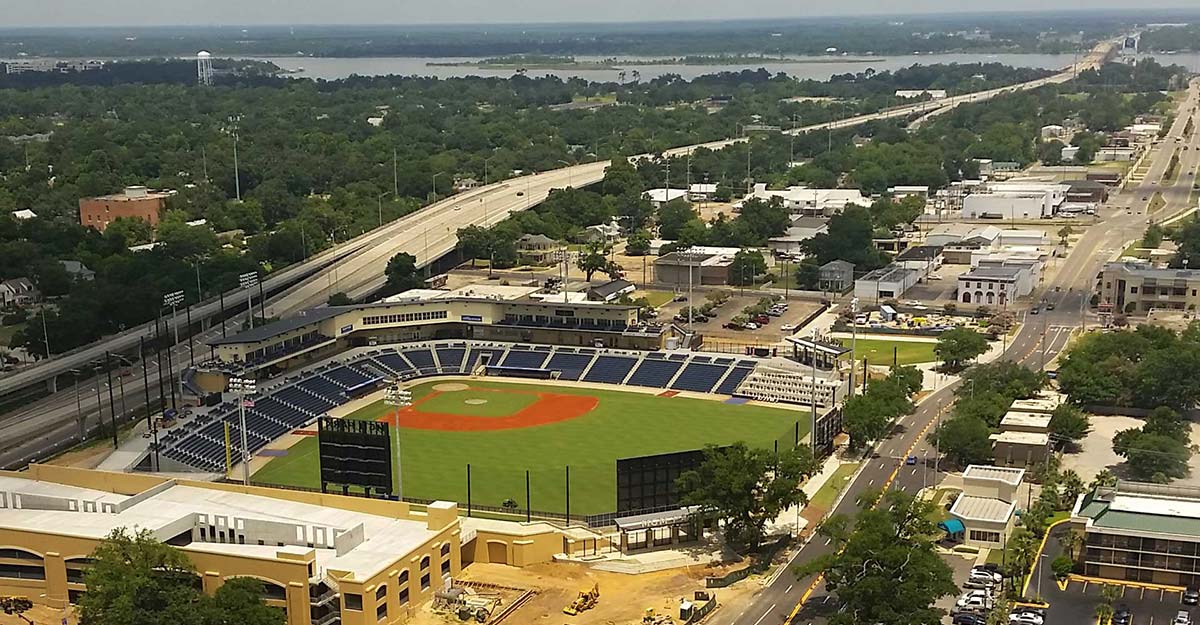Article and all photos by Joe Mock, BaseballParks.com
All rights reserved
It was one of those events in American history. Everyone remembers where they were as they watched cable news to see how much damage Hurricane Katrina was going to inflict on New Orleans. It was the only news story on TV from August 28 through 31, 2005.
My memories are particularly vivid. When I woke up on Saturday, August 28, 2005, I was in New Orleans. The night before, I’d attended an NFL exhibition game in the Louisiana Superdome — the last event there prior to thousands of locals being stuffed inside to take cover from the hurricane. And it was where the storm damaged the roof so severely that it began to leak.
| Ballpark Stats |
| |
| Team: Biloxi Shuckers of the Double-A Southern League |
| First game: June 6, 2015, a 5-4 win over Mobile |
| Capacity: 6,000, including 4,200 fixed seats |
| Architects: Dale Partners |
| Construction: Yates |
| Price: $36 million for entire project. Ballpark itself was $28 million |
| Home dugout: 1B side |
| Field points: southeast |
| Playing surface: Tifway 419 Bermudagrass |
| Betcha didn’t know: The playing field is 21 feet above sea level, the minimum height permitted |
When I woke up that morning, I strolled down to the breakfast area in my hotel, blissfully unaware of what was about to happen. As I walked into the room, I noticed no one was eating. Instead, quite a large crowd had gathered around the big-screen TV, taking in every word being spoken by the CNN host. No one in the room said a thing. They all were taking in the unimaginable news: the path of Hurricane Katrina had veered to the west, and it was heading directly toward New Orleans. It was due to smash into the Crescent City the next day.
I forgot all about breakfast and ran to my room. I hastily checked out, hopped in my rental, and sped to the airport to get out of town. I-10 running from downtown to the airport seemed eerily, crazily empty. In fact, the sun was out. It didn’t seem possible that a massive disaster could be in the forecast for the next day. The reality didn’t sink in for the local residents immediately, but by that evening, that same highway was jammed. And two days later, portions of it would be underwater.
The events of that week are etched in everyone’s memory. Ask the average American today “where did Katrina hit the mainland?” and most would say “New Orleans.”
They’d be wrong.
“On the morning of August 29, the headline in the newspaper was ‘Katrina heads for New Orleans.’ The next day, it was ‘New Orleans dodges bullet,'” recalls Vincent Creel, who handles public relations for the City of Biloxi, Mississippi. “But that’s not the real story. Yes, New Orleans was damaged by the floodwaters when their levees broke, but the real devastation from the storm happened here. It was the largest natural disaster in U.S. history.”
Indeed, the Gulf Coast east of New Orleans had received a blow that was nearly fatal. Hotel after hotel, building after building, house after house … all had been destroyed or severely damaged. In all, 90% of Biloxi’s buildings along the coast were destroyed, and 53 of the city’s residents died in the storm. The storm surge was so high that the Beau Rivage, a casino hotel that is central to the story of Biloxi’s new ballpark, had severe damage all the way up to its third floor.
Fast forward five years, and another disaster completely filled the 24-hour-a-day news cycle: the Gulf oil spill. When an explosion rocked a British Petroleum oil platform off the coast of Louisiana, millions of gallons of crude oil poured into the salty water.
This happened at the beginning of tourist season along the Gulf Coast. And following the spill, tourism there ground to an absolute halt.
What do these two disasters have to do with a new ballpark?
Everything, as you will see.
One person who envisioned professional baseball coming to the Gulfport-Biloxi area was Tim Bennett. “When I was young, I lived in Central Florida. I had a grass-cutting business, and some of my customers were the owners of the Tampa Bay Devil Rays,” he recalled. “They saw something in me, and asked if I’d like to be involved in a change they were contemplating in their Minor League club in Orlando.”
Bennett was able to see what was involved when a franchise changes markets, especially when a new ballpark is involved. After initially thinking the Orlando team might end up in Jackson, Mississippi, they landed in Montgomery, Alabama. The very successful franchise is today called the Biscuits, and they play in beautiful Riverwalk Park.
| Enormous upgrade |
 |
| When the Shuckers were known as the Huntsville Stars, they played in Joe W. Davis Stadium, easily the worst park in the Southern League — and probably in all of Double-A baseball. |
But Bennett saw great potential in Jackson, which had lost its team to Round Rock, Texas when no new ballpark was forthcoming. Consequently, he worked with the state of Mississippi and the Atlanta Braves on moving their Double-A team from Greenville, SC into a brand-new park in the Jackson suburb of Pearl.
However, there was something about the Biloxi-Gulfport area that captivated Bennett. He felt there should be a team there, and starting in 2004, he began researching ways that it might happen. No sooner had he started gaining some momentum when Katrina arrived. “Instantly, baseball was no longer the main focus,” he explained. “The area was just trying to survive, trying to roll up its sleeves and rebuild from all of the devastation.” Once again, he started laying the groundwork for a franchise along the Gulf Coast, and once again, a disaster derailed the plans, as the oil spill killed the lifeblood of the local economy: tourism.
As the region came back, other roadblocks to a team occurred — one of which was political. “At one point, I had the five votes I needed on the (Biloxi) City Council to move forward with a team and a ballpark, but before the vote was taken, two of those Council members resigned and three others were booted out of office. That was disheartening, but it didn’t stop me,” he said.
Another entity that was very instrumental in pushing for a new ballpark was Biloxi architectural firm Dale Partners. Leigh Jaunsen, a partner of the firm, put it this way: “To make the plan come together, we had to have three things lined up: the funding for the park; the land to build it on; a team to play there. So many times during that period, we would have two of the three, but not the third. At one point we had the land picked out and a team to come, but we didn’t have the funding pinned down. Or when we had a funding package in place and a site, we didn’t have a team.”
You might think that convincing a team to move to a new market that’s building a new park would be easy, but even that path was bumpy. The Huntsville Stars of the Southern League played for years in easily the worst park in Double-A baseball, and there were constant rumors that they were ripe for relocation. However, Bennett knew another side of the story. “Miles Prentice (majority owner of the Stars) is a man of his word. He pledged to do everything he could to make it work in Huntsville, and he spent years doing exactly that.” In the end, though, the stadium there was so sub-par that there really was no choice, and Prentice agreed to sell the team Baseball Biloxi, a group led by Ken Young, who also owns the Triple-A team in Albuquerque.
Finally, with Bennett making many of the key connections behind the scenes, a plan came together in May of 2013. The Stars would move from Huntsville to a new park in Biloxi that would be funded by $21 million dollars of bonds to be issued by the City, and the State of Mississippi’s Department of Environmental Quality would add another $15 million. The source of those State dollars? The British Petroleum settlement money following the oil spill. Meanwhile, the company that owns the Beau Rivage, MGM, would lease the city the land for $1 a year in exchange for a parking garage for its employees and naming rights on the ballpark. (Apparently, Minor League Baseball balked at a ballpark being named for a casino — as they should — so that’s why the parent company’s name ended up on the park.)
In December of that year, a contingent that included Mississippi’s governor, Biloxi’s Chief Administrative Officer and Tim Bennett (by now, a part owner of the Stars) attended the Baseball Winter Meetings to seek approval of the franchise move and the change in the team ownership. Within a month, Major League Baseball, Minor League Baseball and the Southern League had all given their approval.
Dale Partners was named the architect, another Mississippi firm (Yates) was named the construction company, and a showy groundbreaking ceremony was held on the site on January 23, 2014. Everything was on target for the franchise’s first game in the new park to be on Opening Day in April of 2015.
But you knew there’d be more challenges to overcome.
“When we started the construction process, we were using the ‘construction manager’ method,” Jaunsen said. Under this, as site preparation was going on, contracts were granted to start the design work. Then they released several design options to construction firms so they could calculate what they would charge to build it. “For various reasons, the proposals that came back were all way over budget. The City then scrapped the whole ‘construction manager’ process and put it out for straight bid. This is what’s called a general works package. Since the City couldn’t actually offer the construction bonds for sale until the final designs were completed, this delayed the City Council from selling the bonds.” These delays caused the construction project to fall way behind — to the point where it became obvious that the ballpark wasn’t going to be finished by April of 2015.
| The mover and shaker |
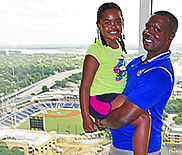 |
| When you talk to officials with the City of Biloxi, the Dale Partners architecture firm and the Shuckers’ front office, one name comes up over and over as being the key person who made MGM Park a reality: Tim Bennett. From the state’s grant of $15 million to a $2 million video board, Bennett is the one who worked behind the scenes to make it happen. In the photo, Bennett is holding his daughter Tatum with MGM Park in the background. |
Since there was no contingency plan for games to be played locally until the new stadium was completed (it marked the first time since 1908 that pro baseball was going to be played in Biloxi, so there was no ballpark in town that could host the team in the interim), the team announced that all games would be played elsewhere until the stadium was completed. “Home” games were played in their old park in Huntsville as well as in Jacksonville and Pearl. In all, the team played the first 54 games of the 2015 season away from Biloxi. The team, now known as the Shuckers, flourished as a road team, clinching the first half championship of the Southern League’s South Division with a week still to go. “Obviously, our players bonded under the adversity,” said Shuckers’ GM Buck Rogers. “Not since my days in the army have I seen a group of young men come together like that.”
In May, the team announced that the first game would be played in their new ballpark on Saturday June 6, and they put tickets on sale on May 11.
Then came one final obstacle.
On May 27, just 10 days before the scheduled opener, newly elected Mayor Andrew “FoFo” Gilich announced that baseball would not be played at MGM Park on June 6 after all, and it could be as late of August 4 before the stadium would be ready. After being taken for a tour of the construction site and being told that it would cost the City $380,000 for Yates to accelerate the construction schedule to get it ready for June 6, the Mayor made the announcement that the home opener was being delayed because of “traffic and parking (and) public safety concerns,” adding “there are still many construction issues to be completed before the stadium could open.”
Undeterred, the team continued selling tickets. They gathered the key stakeholders and just one day after the Mayor had announced that the home opener was being delayed, his office released another statement saying that “a deal has been struck where the city would pay no additional money other than what is already obligated and the stadium can host its first game on June 6.”
And on June 6, the city issued a temporary occupancy permit for the stadium, and the Shuckers went on to win a 14-inning marathon over Mobile, 5-4. A crowd of 5,065 crammed into the partially completed facility, thereby christening the new park.
But professional baseball isn’t the only activity scheduled at MGM Park during the 2015 season. “At the ballpark on the morning of August 29, we’ll be holding an event nicknamed ‘K 10,’ on the tenth anniversary of Katrina,” Creel explained. “We’ll remember the people who perished in that storm — 53 in Biloxi and 97 total in Harrison County. We’ll also thank the first responders and all of the volunteers and everybody who helped in our recovery. We’ve held a memorial service each year on Katrina’s anniversary, but after we do this one on the tenth anniversary, I hope we don’t hold any more.”
The evening of August 29 will be a different kind of event, this one also at MGM Park. The Concert for the Gulf Coast will feature Dr. John and other entertainers as the residents of the area celebrate all they’ve accomplished in the preceding 10 years.
“We’re holding these two events in a building that we think is a testament to the resolve and the spirit of this community,” Creel added.
After Katrina and the Gulf oil spill, the people of Biloxi showed the world that they refused to sit back and wait for the Federal Government to come and fix everything. No, they rolled up their sleeves and went to work — not just rebuilding what had been destroyed, but also making things better — better for the many tourists who keep the local economy humming, but also for the local residents. And just as the city overcame obstacle after obstacle, bringing pro baseball to Biloxi overcame numerous roadblocks. Truly, MGM Park is a testament to Biloxi’s resolve, and puts a crown on the ten-year comeback from Katrina.
But what is MGM Park like? What is it close to, and what is it like to attend a game there? Read on and you’ll find out.
The Setting
As far as markets hosting pro baseball go, Biloxi isn’t all that large. Its population is about 45,000. However, its county (Harrison) includes Gulfport, which is the second largest city in the state of Mississippi, boasting a population of about 68,000. All told, Harrison County has about 187,000 residents — more than enough to support pro baseball.
But it’s not just the permanent residents who support the Shuckers. Keep in mind that tourism is the top industry here, and visitors fill the local casino hotels and inns all through the baseball season.
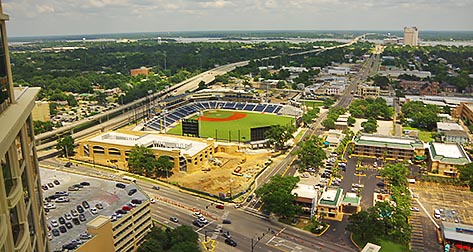
As far as accessibility goes, MGM Park couldn’t be in a better spot. Located near the intersection of Interstate 110 and US Highway 90 (the street in the foreground of the photo above), motorists have easy access to the ballpark.
Highway 90 was originally called the Old Spanish Trail. It runs right along the coast all through Gulfport and Biloxi. Sure, it’s congested, but a drive along it lets you see it all — beaches, piers, hotels, condos, restaurants and exactly half a mile west of the ballpark, Biloxi’s most famous landmark. The Biloxi Lighthouse was constructed in 1848, and perhaps the most amazing aspect of its fascinating history is that it withstood Katrina. Despite a storm surge that completely submerged its base, the mighty lighthouse remained standing. In fact, one of the alternate logos of the Shuckers is an image of this lighthouse with the waves of Katrina crashing into its base.
Over on the east side of the I-110 ramps you’ll find the Beau Rivage, the Hard Rock Casino, a number of docks and quite an expanse of beautiful beaches.
Closer to the ballpark are quite a few interesting sights. You really should arrive at the Shuckers game early and walk through the lovely area of old Biloxi. Here you’ll find the historic Saenger Theater (where the team held its announcement of the team name and logo in November 2014) and the gorgeous Cathedral of the Nativity of the Blessed Virgin Mary, just a block east of the ballpark. In the neighborhood are quaint shops and cafes.
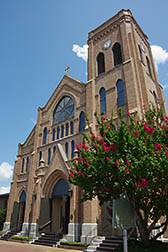  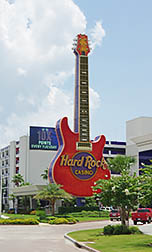 |
| Like the Beau Rivage, the Hard Rock Casino sits on the strip of land between Highway 90 and the waters of the Gulf. The center photo is the Biloxi Lighthouse which sits in the median of Highway 90. The beach in front of the lighthouse is right on the Gulf. The entrance ramps in the foreground are for I-110. On the right is Biloxi’s famous cathedral, just a block east of MGM Park. |
And overlooking all of it is the Beau Rivage, which sits between the ballpark and the waters of the Gulf, just across Highway 90.
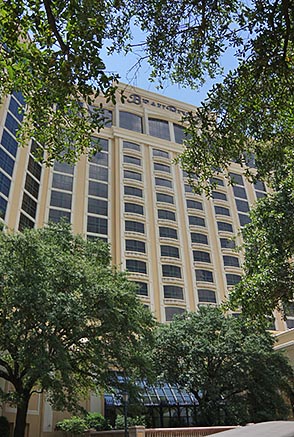    |
| Welcome to the Beau Rivage, the casino hotel that made MGM Park possible by donating the land for the facility. The lobby and casino areas are indeed beautiful. By the way, the BR is quite clever in their strategy to attract baseball fans. Fans are encouraged to park for free in the hotel’s massive garage. Then they are directed down to the hotel’s lobby where restaurants and gaming are just a right-hand turn from the path to the ballpark. And not wanting to miss an opportunity, the BR sells Shuckers apparel and merchandise right on the way to and from the ballpark. |
The exact plot of ground designated for the ballpark has an interesting history. Biloxi’s original resort hotel, the Buena Vista, was located here. It had five stories and 200 rooms and was constructed in 1924. Hurricane Camile in 1969 dealt massive damage to the structure and the grand facility never recovered. To commemorate the fact that MGM Park was built on the very site of this grand hotel, the beer garden down the ballpark’s first-base line is dubbed, of course, Buena Vista.
After the hotel burned down in 1991, the Beau Rivage came to own the land. It used the site for a variety of functions to support the hotel, including a sewage pumping station (which is still there today, although south of the ballpark’s footprint) and surface parking for employees and tour buses. When construction of the ballpark began, several small structures had to be demolished. Their functions were consolidated in a building that still stands just outside the ballpark’s northern exterior.
Interestingly, the site’s northeast corner (currently undeveloped) could add a great feature to the park’s surroundings. An entertainment center complete with bowling lanes could be in the works, and could open as soon as 2016.
The Exterior
While the surroundings of MGM Park are well worth exploring, the facility’s exterior isn’t its strongest aspect. It features the same color and construction materials (including a stucco look) that match the Beau Rivage — which makes sense, since the massive hotel is visible from just about every spot in the ballpark. But the structure isn’t likely to draw stares like, say, El Paso’s Southwest University Park or Birmingham’s Regions Field.
 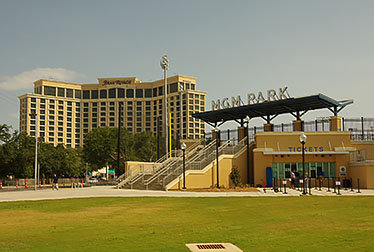 |
During the parks’ first season, there is only one entryway (above left). It sits at the northeast corner of the park, next to the left-field foul pole. Because the main concourse is well above the field level, a grand stairway leads you to the gates. The main ticket windows are next to the stairs … and there’s no missing the Beau Rivage two blocks away.
Like Monongalia County Ballpark in West Virginia, there is no entry behind home plate. In West Virginia, it’s because the park was built into the side of a hill. In Biloxi, pedestrians can’t really access that part of the park’s exterior. In fact, on the first base side, cars on I-110 zip by quite close to the walkway behind the luxury suites (above right). This is quite similar to the Interstate lanes that are mere feet from the edge of Busch Stadium in St. Louis. By the way, the water in the distance of the picture above is the Gulf. This is one of the few places in the park where you can see it.
Beyond the ballpark’s right field is the parking garage that was still under construction when the park opened. When finished, it won’t be for the average Shuckers fan to use. Instead, it’s for employees of the Beau Rivage. Shuckers players and coaches will be allowed to park there, as will luxury-suite holders.
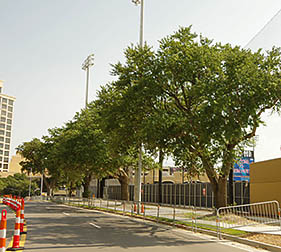 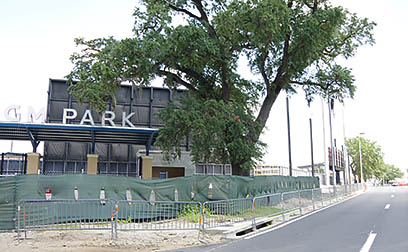 |
Directly beyond the batter’s eye in center field is an entryway that wasn’t completed when I visited (above left). Once finished, it will be the natural entry point for the hundreds of fans who park (for free) in the Beau Rivage’s main parking garage, since it is almost directly across the street.
Between the finished entry and the unfinished one is a pleasant tree-line walkway that runs parallel to the left-field fence (above right).
Keep reading for a look inside MGM Park — including its wonderful, local seafood!
